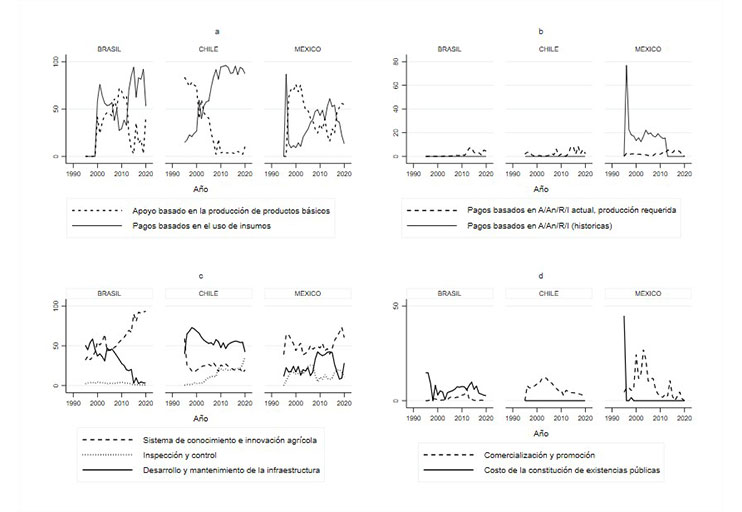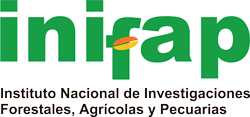Policy instruments, subsidies and value of agricultural production: Mexico, Brazil and Chile
DOI:
https://doi.org/10.29312/remexca.v15i4.3318Keywords:
agricultural policy instruments, general service support estimator, producer support estimator, transfersAbstract
Transfers, in the form of subsidies, are a government intervention aimed at boosting economic development. These are provided through various instruments that affect production and trade. The Organisation for Economic Co-operation and Development classifies these instruments into categories from most to least distorting. In its strategy of deregulating the world market, it encourages the use of the latter in agricultural policy. Nonetheless, the effect of this recommendation on the value of agricultural production has been poorly researched. This work assessed the relationship between the amounts of support in different agricultural policy instruments used and the value of the production of subsidized agricultural products (VpS) in Mexico, Brazil, and Chile during the period 1995-2020, through a multiple linear regression model with the stepwise backward elimination procedure. The results show that the transfer items that were relevant to explain the VpS in Mexico were: storage, marketing and other physical infrastructure, support based on area and number of animals, extension services, safety and inspection of agricultural products and institutional infrastructure (p< 0.05), in Brazil they were: research, market prices and education (p< 0.05) and in Chile they were: research, storage, marketing and other physical infrastructure, and farm restructuring (p< 0.05). It should be noted that all instruments with a significant effect on the VpS are classified as less distortive, except for the market price support present in Brazil.
Downloads
References
Ackermann, M. N.; Buonomo, M.; Muñoz, G.; Cortelezzi, Á.; Barboza, N. y García, F. 2018. Análisis de las políticas agropecuarias en Uruguay: Cuantificación de los apoyos específicos 2014-2016 y su vinculación con las emisiones de gases de efecto invernadero. In: análisis de las políticas agropecuarias en Uruguay. 57 p. https://doi.org/10.18235/0001196.
Antón, J. 2004. El desacoplamiento de los apoyos a la agricultura: una perspectiva internacional. Economía Agraria y Recursos Naturales. 4(8):3-19.
Arisoy, H. 2020. Impact of agricultural supports on competitiveness of agricultural products. Agricultural economics. (6):286-295. https://doi.org/https://doi.org/10.17221/416/2019-AGRICECON.
Arisoy, H.; Bayramoglu, Z.; Karakayaci, Z. and Oguz, C. 2017. The effect of agricultural support on the economic sustainability of agricultural enterprises. Custos e Agronegocio. 13(3):233-253.
Banxico. 2022. Banco de México. Índice de precios al consumidor. [Database]. https://www.banxico.org.mx/SieInternet/consultarDirectorioInternetAction.do?accion=consultarCuadro&idCuadro=CP154&locale=es.
Bataineh, O.; Abu-Fares, M. and Al-Jdayeh, M. 2022. On the factors that affect concentration variations in a veterinary drug using backward stepwise regression analysis. AIP conference proceedings. 2440(1):1-18. https://doi.org/10.1063/5.0075137.
Bielik, P.; Juríček, P. and Kunová, D. 2007. The comparison of agricultural support policies in the OECD and the EU countries from the perspective of economic globalization processes. Agricultural economics. 53(8):339-348. https://doi.org/https://doi.org/10.17221/902-AGRICECON.
Dewbre, J.; Antón, J. and Thompson, W. 2001. The transfer efficiency and trade effects of direct payments. American Agricultural Economics Association. 83(5):1204-1214.
Dias, S. J. and Brito, M. R. F. 2008. La educación superior en Brasil: principales tendencias y desafíos. Avaliação: Revista da Avaliação da Educação Superior Campinas. 13(2):487–507. https://doi.org/10.1590/s1414-40772008000200011.
Effland, A. 2011. Classifying and measuring agricultural support: identifying differences between the WTO and OECD Systems. In USDA (Issue 74). USDA. 13-20 pp.
Erokhin, V.; Ivolga, A. and Heijman, W. 2014. Trade liberalization and state support of agriculture: effects for developing countries. Agricultural Economics. 60(11):524-537. https://doi.org/10.17221/137/2013-agricecon.
FOCIR. 2022. ¿Qué hacemos? https://www.gob.mx/focir/que-hacemos.
Frohmann, A.; Mulder, N. and Olmos, X. 2020. Incentivos a la sostenibilidad en el comercio internacional. Documentos de proyectos (LC/TS.2020/160), Santiago. Comisión Económica para América Latina y el Caribe (CEPAL). 34-115 pp.
Gallacher, M. and Lema, D. 2014. Argentine agricultural policy: producer and consumer support estimates 2007-2012. Universidad del CEMA. Serie Documentos de Trabajo 4575. 1-22 pp. https://ri.conicet.gov.ar/handle/11336/44601.
Gao, C.; Zhong, Y.; Mensah, I. A.; Tao, S. and He, Y. 2022. Spatio-temporal impact of global migration on carbon transfers based on complex network and stepwise regression analysis. Sustainability. 14:1-13. https://doi.org/10.3390/su14020844.
Gómez, O. L. y Tacuba, S. A. 2017. La política de desarrollo rural en México. ¿Existe correspondencia entre lo formal y lo real? Economía UNAM. 14(42):93-117. https://doi.org/10.1016/j.eunam.2017.09.004.
Gong, Y. y Guo, C. 2022. Logros y perspectivas de los intercambios pueblo a pueblo desde el establecimiento de relaciones diplomáticas entre China y Chile. Ibero América Studies. 4(2):39-50.
Gurria, M.; Boyce, R. and De Salvo, C. P. 2016. Revisión de las políticas de apoyo agrícolas en América Latina y el Caribe. Nota técnica N° IDB-TN-1092. Washington DC. 1-17 pp. https://doi.org/IDB-TN-1092.
Happe, K.; Kellermann, K. and Balmann, A. 2006. Agent based analysis of agricultural policies: an illustration of the agriculutural policy simulator agripolis, its adaptation and behavior. Ecology and Society. 11(1):1-28. https://doi.org/10.5751/es-01741-110149.
Instituto de Estadística de Brasil. 2022. Índice de precios al consumidor. Base de datos del Instituto de Estadística de Brasil. https://www.ibge.gov.br/estatisticas/economicas/precos-e-custos/9258-indice-nacional-de-precos-ao-consumidor.html?=&t=downloads.
Instituto de Estadística de Chile. 2022. Índice de precios al consumidor. Base de datos del Instituto de Estadística de Chile. http://www.ine.cl.
Jana, C. 2008. Buenas prácticas agrícolas mejorando la calidad e inocuidad de los productos agrícolas. INIA tierra adentro. 24-26 pp. file:///C:/Users/AMINTA/Downloads/BPA.pdf.
Kimura, S.; Antón, J. and Lethi, C. 2010. Farm level analysis of risk and risk management strategies and policies. Cross Country Analysis. OECD Food, Agriculture and Fisheries Papers, No. 26, OECD Publishing, Paris. 37-43 pp. http://dx.doi.org/10.1787/5kmd6b5rl5kd-en.
Lema, D. and Gallacher, M. 2015. Argentine agricultural policy : economic analysis and impact assessment using the producer support estimate. Approach. International Conference of Agricultural Economists. 1-29 p.
Lovo, S.; Bezabih, M. and Singer, G. 2015. Green agricultural policies and poverty reduction. Grantham Research Institute on Climate Change and the Environment, Global Green Growth Institute (GGGI), London School of Economics and Political Science (LSE). 10-16 pp. https://gggi.org/wp-content/uploads/2017/11/2015-01-Green-agricultural-policies-and-poverty-reduction.pdf.
Luna Morales, M. E.; Luna-Morales, E. y Sánchez Martínez, U. 2013. Patrones de producción e impacto científico del centro internacional de mejoramiento de maíz y trigo (CIMMYT): 1966-2010. Investigación Bibliotecológica. 27(60):97-124. https://doi.org/10.1016/S0187-358X(13)72545-0.
Morris, M.; Sebastian, A. R. y Eugenia-Perego, V. M. 2020. Panoramas alimentarios futuros. Banco Mundial. Washington, DC. 2-76 pp.
OECD. 2001. Decoupling: a conceptual overview. OECD papers. 5(11):5-30. https://doi.org/10.1787/oecd-papers-v5-art37-en.
OECD. 2016. OECD’S producer support estimate and related indicators of agricultural support concepts, calculations, interpretation and use (The PSE Manual). 13-187 pp. http://www.oecd.org/agriculture/topics/agricultural-policy-monitoring-and-evaluation/documents/producer-support-estimates-manual.pdf .
OECD. 2022a. Agricultural policy monitoring and evaluation 2022: Reforming Agricultural Policies for Climate Change Mitigation. 159-199 pp. https://www.oecd-ilibrary.org/sites/7f4542bf-en/index.html?itemId=/content/publication/7f4542bf-en#section-d1e1158.
OECD. 2022b. Agricultural policy monitoring and evaluation: all data. OECD database. OECD. https://stats.oecd.org/.
Park, J. H. and Jensen, N. 2007. Electoral competition and agricultural support in OECD countries. American journal of Political Science. 51(2):314-329. https://doi.org/10.1111/j.1540-5907.2007.00253.x.
Pehlivanoğlu, F.; Erarslan, C. and Demir, S. 2021. Factors affecting competition in olive oil exports: panel data analysis of selected countries. Case study. agricultural economics. 12:511-518. https://doi.org/https://doi.org/10.17221/494/2020-agricecon.
Quiñonez-Salcido, A. y Travieso-Bello, C. A. 2020. Gasto público en educación e investigación agrícola de México (1995-2010). Agricultura Sociedad y Desarrollo, 17:471-488.
Ramírez-Álvarez, M.; Santoyo-Cortés, V. H.; Rendón-Medel, R. and Jiménez-Carrasco, J. S. 2022. Factores del diseño e implementación asociados al desempeño de un programa de extensión en México. Revista Mexicana de Ciencias Agrícolas. 13(2):235-246. https://doi.org/10.29312/remexca.v13i2.2722.
StataCorp. 2017. Stata Statistical Software: Release 15. College Station, TX: StataCorp LLC. 2563-2565 pp.
Wooldridge, J. M. 2010. Introducción a la econometria. Un enfoque moderno. In: angewandte chemie international. 4ta. Ed. 274-276 pp.
World Bank. 2021. Piezas para el desarrollo: notas de política para Chile. World Bank. Washington, DC. License: CC BY 3.0 IGO. 165-169 pp. https://openknowledge.worldbank.org/handle/10986/36466.
WTO. 2006. World trade report. Exploring the links between subsidies, trade and the WTO. Technical notes. 23-27 pp. https://www.wto.org/english/res-e/booksp-e/anrep-e/world-trade-report06-e.pdf.
Zavala-Pineda, M. J.; Leos Rodríguez, J. A.; Salas-González, J. M.; Valdez-Cepeda, R. D. y Gómez-Oliver, L. 2015. Las transferencias agrarias en México y su efecto en el sector agropecuario. Economía Agraria y Recursos Naturales. 15(2):31-49. https://doi.org/10.7201/earn.2015.02.02.Centro.
Żogała-Siudem, B. and Jaroszewicz, S. 2021. Fast stepwise regression based on multidimensional indexes. Information Sciences. 549:288-309. https://doi.org/10.1016/j.ins.2020.11.031.

Published
How to Cite
Issue
Section
License
Copyright (c) 2024 Revista Mexicana de Ciencias Agrícolas

This work is licensed under a Creative Commons Attribution-NonCommercial 4.0 International License.
The authors who publish in Revista Mexicana de Ciencias Agrícolas accept the following conditions:
In accordance with copyright laws, Revista Mexicana de Ciencias Agrícolas recognizes and respects the authors’ moral right and ownership of property rights which will be transferred to the journal for dissemination in open access. Invariably, all the authors have to sign a letter of transfer of property rights and of originality of the article to Instituto Nacional de Investigaciones Forestales, Agrícolas y Pecuarias (INIFAP) [National Institute of Forestry, Agricultural and Livestock Research]. The author(s) must pay a fee for the reception of articles before proceeding to editorial review.
All the texts published by Revista Mexicana de Ciencias Agrícolas —with no exception— are distributed under a Creative Commons License Attribution-NonCommercial 4.0 International (CC BY-NC 4.0), which allows third parties to use the publication as long as the work’s authorship and its first publication in this journal are mentioned.
The author(s) can enter into independent and additional contractual agreements for the nonexclusive distribution of the version of the article published in Revista Mexicana de Ciencias Agrícolas (for example include it into an institutional repository or publish it in a book) as long as it is clearly and explicitly indicated that the work was published for the first time in Revista Mexicana de Ciencias Agrícolas.
For all the above, the authors shall send the Letter-transfer of Property Rights for the first publication duly filled in and signed by the author(s). This form must be sent as a PDF file to: revista_atm@yahoo.com.mx; cienciasagricola@inifap.gob.mx; remexca2017@gmail.
This work is licensed under a Creative Commons Attribution-Noncommercial 4.0 International license.


